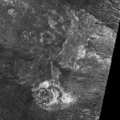Cryovolcano facts for kids
A cryovolcano (also called an "ice volcano") is a special kind of volcano. Instead of erupting hot, melted rock like volcanoes on Earth, cryovolcanoes erupt cold liquids or gases. These can be things like water, ammonia, or methane.
Cryovolcanoes are usually found in very cold places far from the Sun. This includes icy moons that orbit giant planets, and possibly other icy objects in the outer Solar System, like those in the Kuiper belt.
Contents
What is a Cryovolcano?
A cryovolcano is like a regular volcano, but it works with ice and cold liquids instead of hot lava. The word "cryo" means "cold" or "ice."
Instead of molten rock, these volcanoes erupt substances called volatiles. These are materials that can easily turn into a gas, even at very low temperatures. For cryovolcanoes, these volatiles are often:
- Water (which can be liquid or ice)
- Ammonia
- Methane
When these materials erupt, they can form icy flows or plumes of gas and ice particles.
Where are Cryovolcanoes Found?
Scientists have found cryovolcanoes on several icy moons. These moons are usually very far from the Sun, where temperatures are extremely cold.
Some places where cryovolcanoes have been discovered or are thought to exist include:
- Icy Moons: Moons like Triton (which orbits Neptune) and Enceladus (which orbits Saturn) are known to have cryovolcanic activity.
- Kuiper Belt Objects: These are icy bodies found beyond Neptune in the outer Solar System. Scientists think some of them might also have cryovolcanoes.
Famous Cryovolcanoes
Some of the most well-known cryovolcanoes are found on moons in our own Solar System.
Triton's Cryovolcanoes
Triton is the largest moon of Neptune. The Voyager 2 spacecraft flew past Triton in 1989 and saw dark plumes erupting from its surface. These plumes were likely made of nitrogen gas and dust, shooting several kilometers high. This showed that Triton is still geologically active, even though it is very cold.
Enceladus's Cryovolcanoes
Enceladus is a small, icy moon of Saturn. The Cassini spacecraft discovered huge plumes of water vapor and ice particles erupting from its south pole. These plumes come from cracks in the ice, often called "Tiger Stripes."
These eruptions on Enceladus are very powerful. They even help create one of Saturn's rings, the E Ring. Scientists believe there is a large ocean of liquid water beneath Enceladus's icy surface, and the cryovolcanoes are how this water escapes into space. Studying these plumes helps scientists learn about the ocean and if it could support life.
Titan's Cryovolcanoes
Titan is Saturn's largest moon and has a thick atmosphere. Scientists believe Titan might also have cryovolcanoes. Features like Doom Mons and Sotra Patera are thought to be cryovolcanic mountains and craters. Instead of water, Titan's cryovolcanoes might erupt a mix of water ice and ammonia, which would be like very cold, thick lava.
Images for kids
See also
 In Spanish: Criovolcán para niños
In Spanish: Criovolcán para niños





